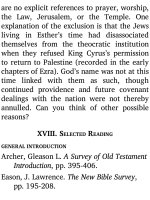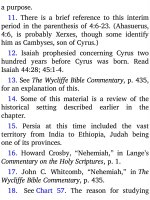Jensens survey of the old testament adam 256
Bạn đang xem bản rút gọn của tài liệu. Xem và tải ngay bản đầy đủ của tài liệu tại đây (117.78 KB, 4 trang )
Nahum prophesied their fall (e.g., 2:5-6). In
6 1 2 B.C. Nineveh was conquered and
demolished by the Babylonians, Medes, and
Scythians. The city has remained through all
the centuries as a heap of desolate ruin.
Recall your earlier studies of the prophet
Jonah (see Chart 98). Jonah was a prophet
of Israel, whom God sent to preach to
Nineveh. Nahum was a prophet of Judah,
but his ministry also involved Nineveh.
(Read Jonah 1:1-2 and 3:1-10.) What was
Jonah’s message; the people’s reaction; and
God’s response? Was a speci c destruction
of Nineveh foretold? Jonah 3:5 says, “Then
the people of Nineveh believed in God.” Do
you think this generation of believers had
been replaced by the time Nahum came on
the scene?
B. THE BOOK OF NAHUM
1. Date. Nahum wrote his book some time
after 663 and before 612 B.C. This dating is
based on his reporting of the fall of Thebes
(3:10), which had already taken place (663
B.C.), and on his foretelling the fall of Nineveh
(e.g., 2:8-10), which was still future (612
B.C.). Chart 108 shows Nahum’s public
ministry extending from about 650 to. 620
B.C.
2. Theme and purpose. The theme of
Nahum may be stated thus: The Lord, in His
sovereign holiness and goodness, will bring
judgment upon sinful Nineveh, and spare
righteous Judah. The book is mostly about
Nineveh, the subject which the opening
sentence (1:1) introduces. It is also
addressed mainly to Nineveh. It is the sequel
to the book of Jonah.
Nahum also wrote for the bene t of the
people of Judah. He clearly answered
questions raised by his brethren, such as:
Why does cruel Nineveh prosper?
Has God abandoned Judah?
Where is justice?
Do these questions have their counterparts
in the world today?
II. SURVEY
1. Read Nahum 1:1. What does this
introductory verse suggest as to what
Nahum’s message is about? Scan the
remainder of the book to get the feel of the
prophet’s burden.
2. Follow the progression of Nahum’s
thought by using the following outline:
I. God the Sovereign Judge (1:2-8)
(What are the different things said about
God here?)
II. Nineveh to Fall, and Judah to Be
Protected (1:9—2:2)
Here Nahum alternates back and forth
between the two subjects of judgment
and deliverance. Observe what is said
about Judah or Nineveh in each case:
l:9-12a Nineveh
2:1 Nineveh16
1:126-1315
Judah 2:2 Judah
1:14 Nineveh
1:15 Judah
III. The Fall (2:3-13)
IV. The Causes (3:1-19)
3. Study the survey Chart 109, and try to
determine what each outline or entry is
based on, in the Bible text.
4. Note the following on the chart:
a) There is a natural progression in the
book. (See bottom of the chart. Also
note the progression in the three
sections, beginning with Nineveh to fall.)
b) How is the first paragraph (1:1-8) set off
from the rest of the book?









